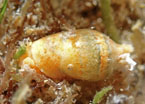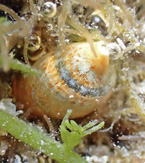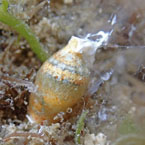| Home |
| Acknowledgments |
| Conventions |
| Glossary |
| Maps |
| References |
| Links |
| Articles |
| Thumbnails |
| Species
list |
| Family |
| Next
species |
Additional Photos

live animal

apex

defensive fluid

Volvatella vigourouxi (Montrouzier, 1861)

| Maximum size: 6.5 mm shell
length (Terry Gosliner, pers. com.). Identification: This species has a thin, largely transparent shell that narrows into a spout posteriorly and has a medial constriction that varies in prominence. The animal is light orange, flecked with darker orange and grayish white (the latter in spiral bands below the apex). Natural history: The few known specimens of Volvatella vigourouxi have been found in shallow water on Caulerpa sp. Like Volvatella ventricosa, it releases a milky fluid when disturbed, presumably for defensive purposes. (Note 1) Distribution: Oahu: widely distributed in the Indo-Pacific. Taxonomic notes: This may be the animal listed in Kay, 1979 and Kay & Schoenberg-Dole, 1991 as Volvatella pyriformis. Details of color and form appear to be a good match for the original description of that species. If so, it was first reported from Hawaii in Pease, 1868. Photo: Terry Gosliner: narcotized: Oahu. Observations and comments: Note 1: Thomas Irvine stated that his animal "was initially found burrowing into some algae in a tidepool, but when I pulled it out it began spewing white stuff (ink? viscera?) before crawling away and burrowing back into some algae." |
| Thumbnails |
Species
list |
Family | Next species | Top |